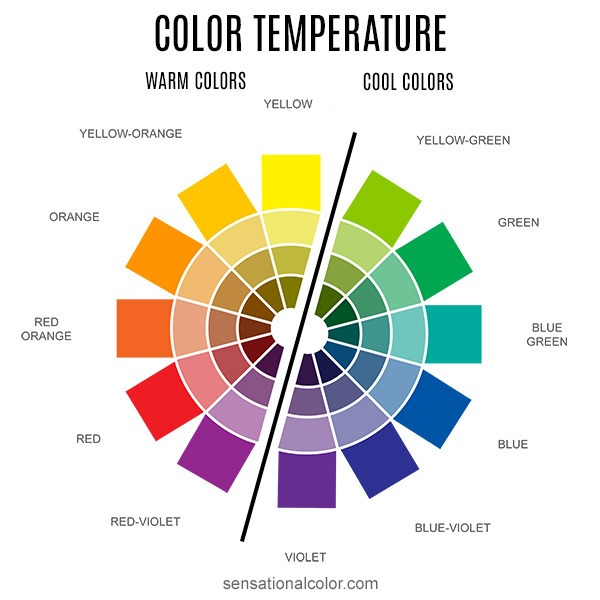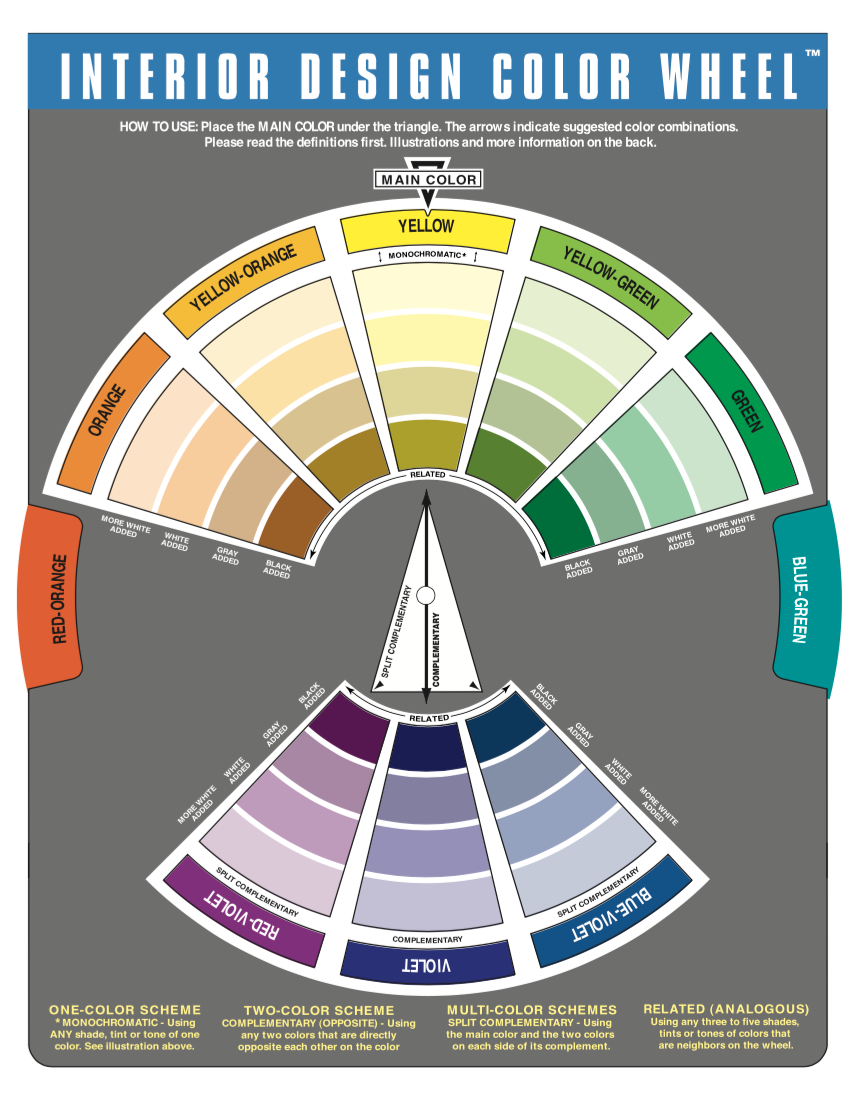Table Of Content

The two colors appear on other elements throughout the space for a cohesive look. Today we are surrounded by a considerable number of colors and shades. It is challenging to choose those suitable for your interior and harmoniously combined with each other – if you act “by eye”. However, designers for a very long time and do not work so energy-intensive. In fact, finding the perfect color combinations is extremely easy if you are guided by the color wheel, which has been helping interior designers for at least half a century.
Christine Vroom Interiors

It’s worth bearing in mind that while the colour wheel is a useful tool for identifying contrasting colours, we still need to be a little mindful of how we go about using them within our homes. While some of the colour palettes are tried and tested, others may well surprise you. We've put together an easy guide to get you up to speed, and boost your colour confidence in the process. 'The colour wheel is a scientifically developed illustration of how assorted colours interact with one another. One of the big benefits of using the colour wheel is that you can apply your choices to an online palette tool for a range of choices across a much broader spectrum. Simply put, combining the colour wheel with a palette tool maximises your choices,' says Adam Brown, director, The Painted Furniture Company.
Ask yourself 4 questions before you choose colors
In addition to the three primary and three secondary colors, we have six tertiary colors that form a circle of twelve sectors. The distance relationship between each color on the wheel provides you with an understanding of how each color can match up with the remaining shades on the color wheel. Using these 12 color tones, you can easily maintain color discipline when it comes to pairing up similar and contrasting colors for accents and blending within your home. And design is meant to be fun and from the heart - not slavishly following a chart.
Analogous colour palette in the colour wheel
Warm colors like reds, oranges, and yellows will make your home feel cozy and lively. Cool colors like blues, greens, and purples are chill and relaxed. One-Color Scheme – also called monochromatic – this color scheme uses any one color and all of its shades, tints, or tones. This scheme is very easy to implement and is a good place to start if you are unsure of yourself and your color choice, or if you like a subdued and subtle look.
Color Combinations
This tool is terrific for learning and experimenting with color. Once you see complementary colors you love, pop them into a color-matching tool to find brands closely resembling each shade. For example, we want to create an interior palette based on blue and light blue tones.
Add banners or bunting
Using a color wheel to build color schemes also needs an understanding of the different types of color schemes for your home decor ideas. These are the schemes you will need to consider on the color wheel in combination with color theory. We list them below and include interior design tips to make the guide more useful. The color wheel was actually created by Sir Isaac Newton with his experiments with the visible color spectrum! If you need a refresher, the color wheel shows the 12 colors that make up every color.
These colors are typically found on one side of the color wheel and include reds, oranges, and yellows. When used in interior design, warm colors can create a cozy and inviting atmosphere, making a space feel welcoming and vibrant. As the name suggests, this color scheme takes inspiration from nature. An example is a flowering plant that has bright green leaves and bloody red flowers. Another example is purple, blue, orange and pink which can be found in a bird’s feathers. Although these colors do not really fit in a specific scheme, they fit well together and create a beautiful harmony of colors.
The result is a room that’s full of energy and warmth, yet still feels balanced and cohesive. A triad creates an adventurous palette by using three hues evenly spaced on the wheel, such as turquoise, fuchsia, and yellow-orange. This combination forms a color palette with vivid contrasts and balanced colors.
Complementary colors
Alternatively, cool colors produce calm and relaxing vibes in a home. Using the color wheel can help you select a color palette that adheres to one type of shade, or one that traverses the wheel and incorporates a mixture of warming and cooling tones in a single space. Split complementary colors can be applied to various aspects of interior design, such as wall paint, furniture upholstery, accessories, or artwork selection. By incorporating these color combinations, you can create a visually captivating and harmonious space that is sure to make a statement. By using analogous colors in your interior design, you can create a space that feels cohesive, balanced, and visually pleasing. The subtle variations within the color scheme add depth and interest to the overall design.
If you were to draw a perfectly equilateral triangle over the color wheel, each of these three primary colors would sit at a different corner of the triangle. Warm-toned colors (reds, oranges, yellows, and pinks) can make a space feel warm, inviting, and cozy. However, too many warm tones in one area can make a room feel closed off. Greens tend to soothe, while yellows are uplifting and energetic.
The tetradic color scheme also known as double complementary colors is the most complicated scheme to balance. This scheme consists of four colors which is made up of two sets of complementary colors. This scheme is considered the richest but the hardest to harmonize.
How to Design With Peach Fuzz, Pantone’s 2024 Color of the Year - Mansion Global
How to Design With Peach Fuzz, Pantone’s 2024 Color of the Year.
Posted: Wed, 13 Dec 2023 08:00:00 GMT [source]
Analogous colors are groups of colors that are adjacent to each other on the color wheel. These colors share similar tones and have a harmonious relationship. When used together in interior design, analogous colors create a cohesive and soothing atmosphere in your space.
The multifaceted design software has so many features to choose from that it makes it easier to visualize your design ideas more effectively. For example, if a bathroom or study space is small, consider using a single color and deriving its shades to paint the area. Innocence, purity, and completion — these are the words used to describe white psychologically as well as in interior design. The right shade of white can make a room look modern and stylish. Cool colors are popular choices for spaces where a sense of calmness and relaxation is desired. They work well in bedrooms, bathrooms, or any area where you want to create a soothing and peaceful atmosphere.
While the entire scheme is based on one color, designers use a variety of tones, sheens, and textures in order to create variation and visual interest. Here, the dark red of the door and frames is offset by the dark pink of the tiles, bringing the best out of both. The wheel that’s used by today’s interior designers actually derives from Sir Isaac Newton’s first circular illustration for colour in 1666. It's made up of 12 hues, half of which are warm colours (reds, oranges and yellows) and the other half cool colours (lilacs, blues and greens). Adding any three primary spectral colors (red, green, or blue) to any other color, along with white, creates a color combination.
Visualize Color allows you to virtually "paint" a room or create a palette explicitly suited to your home. You can easily add color choices to a list to save offline and take to your local paint supply store. Later this experience was deepened by the Swiss artist Johannes Itten.

